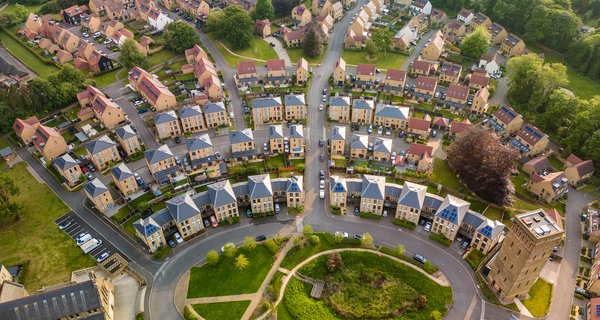Findings – whole life costs
The modelling also explored the difference between current heating systems and heat pumps when considering whole life costs including upfront and maintenance costs over an expected 15-year lifetime as well as running costs. Currently, the upfront costs of heat pump installations present a challenge to their widespread adoption requiring government subsidies to bridge the gap. Maintaining the current level of subsidy will become challenging for public finances as heat pumps become more popular.
CAR’s modelling allowed us to explore the conditions that would be required to generate total cost savings for households adopting heat pumps in 2028 under our price scenarios. Figure 2 shows the percentage of homes that make total life cost savings where the total costs over 15 years are the same or cheaper than the expected costs of sticking with a fossil fuel boiler.
We modelled three levels of heat pump installation grant (£4,500, £7,000 and £9,500) to maximise the number of homes making total cost savings. The results in Figure 2 are given by price scenario and with standard and TOU tariffs.
We only include houses because flats have poorer running cost economics and they should be less affected by the ‘at purchase’ proposal from the Scottish Government. We used today’s estimated installation costs and did not factor in any installation cost reductions. Improvements in heat pump efficiency would also improve these results but this was beyond the scope of this analysis. Nesta has published other modelling work exploring how these different factors interact with each other. In this analysis, we did not factor in an interest rate or discount rate – currently, all homes in Scotland can get an interest-free loan towards the cost of a heat pump from Home Energy Scotland, supported by the Scottish Government.
Figure 2 - Percentage of houses making lifetime cost savings
Image Description
This column chart shows the percentage of houses making lifetime cost savings, split by wide, medium and narrow scenarios and standard tariffs and time-of-use tariffs. The savings are modelled on three levels of heat pump installation grant (£4,500, £7,000 and £9,500). The chart shows that the percentage of houses making lifetime cost savings increases from wide to medium and narrow scenarios and increases from standard to time-of-use tariffs. The percentage of houses making the biggest lifetime savings with the £9,500 grant model is highest in the narrow scenario using both standard (93%) and time-of-use tariffs (97%).
The results highlight that government grants will continue to be important to ensure people benefit from the transition (reduced installation costs and improved heat pump efficiency would also reduce the need for subsidy). TOUs play an important role by increasing the proportion of homes making savings in all scenarios, by up to 20%. The impact varies by scenario due to various factors within the modelling.
The homes in the modelling requiring higher grant levels have more challenging heat pump economics. Around 40% of homes in the modelling have either higher running costs or other factors that add to capital costs – constraints that affect energy efficiency and heat pump installation were modelled: heritage status, limited internal space and corrosion protection for homes near the coast. See the original CAR report for more details.
Some homes require much lower grant support and it could become prudent in the future for the Scottish Government to offer a sliding scale of support to ensure value for money to the taxpayer – especially when it's possible that homeowners will benefit from some of the money invested in the heat pump through higher home valuations.
Our key finding is that with the right policies on electricity pricing and grants, the vast majority of houses in Scotland could be better off after fitting a heat pump in 2028.





